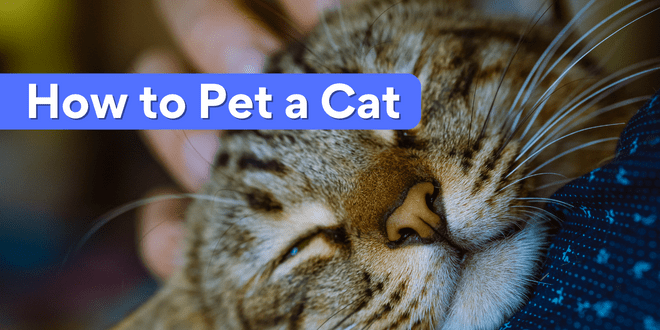
I know this may seem very obvious and something you certainly wouldn’t need instructions for, but surprisingly, there are people who do it wrong. When it’s done incorrectly, kitty isn’t happy and people end up scratched or bitten.
Cats are social creatures. They have often been mislabeled as solitary animals but they form social groups that revolve around the availability of resources. Cats can form close bonds with other cats, humans, dogs and even animals you wouldn’t suspect such as rabbits, birds, and more. Most likely, people are confused by the fact that cats are solitary hunters as well as having such a strong sense of territory.
Cats are also affectionate despite the myths you’ve heard about them being aloof. Cats show affection in a multitude of ways and some of those displays are often missed by an unaware cat parent. Cats show affection and strengthen bonds with other cats in their social group by grooming each other. This also helps the colony create a group scent which is important in identification. Cats who are friends will also play together, rub against each other, and sleep close together. When walking next to each other, two closely bonded cats may display tail twining.
Your cat uses many of those behaviors to strengthen the bond she shares with you. Playing, Rubbing, head bunting and being physically close are just a few of the ways they show affection.
Most cats also enjoy being petted and touched but there are right and wrong ways to do it though. When petting cats, you want to make sure the experience is a positive one for them. Here are some tips.
Respect Your Cat’s Personal Space
Just because your cat may enjoy being petted doesn’t mean she wants it all the time. Be respectful of personal space because there may be times when kitty simply wants to be alone. When your cat is sitting at the window and is focused on a bird outside may not be the time to startle or distract her just for a little petting. There may also be specific locations in the home that she prefers to be “people-free” zones. My cat, Pearl, for example, views the top perch of her cat tree as a people-free spot. When she’s up there, even though I could easily reach her, I leave her alone. Her body language let me know long ago about this preference and I respect it. I will admit though, it’s very tempting when I see her up there but having her trust is more important.
Correctly Interpret Your Cat’s Body Language
Just because your cat approaches you doesn’t mean she wants to be petted. Your cat may be meowing as a food request or is asking for playtime. If your cat rubs up against you or leans against you, she’s likely showing affection, and based on what you know about your kitty, being petted is probably desired. Every cat is an individual though, so get familiar with how your cat requests affection vs playtime.
https://catbehaviorassociates.com/buy-pams-books/
If it’s an unfamiliar cat, don’t automatically reach out and start petting. Let the cat become familiar with your scent first by extending your index finger. This way she can sniff it, in the same way cats engage in nose-to-nose sniffing. If the cat rubs against your hand or comes closer, she’s probably comfortable with being petted. Keep watching body language though because it could change.
Learn the Cat’s Petting Preference
Typically, cats enjoy being petted on the top of the head, between the ears and down the back of neck. Many cats also enjoy getting lightly scratched under the chin or rubbed along the side of the cheek (just be sure to stay away from those sensitive whiskers.) If you’re unfamiliar with the cat, don’t move your hand directly over her face, but rather, come in from the side so you don’t appear threatening. If the cat backs up or leans away from you, immediately stop petting. The cat is letting you know she’s not ready.
Some cats enjoy being petted down the back all the way to the tail. Others find that unpleasant or even painful. If you attempt to pet those areas, watch the cat’s body language very carefully. Petting along the back or near the tail can even trigger an unexpected aggressive response.
When cats groom each other, they tend to stick to the head area. It’s a good idea to follow that wisdom when petting, but again, pay attention to your own cat’s preference.
Leave The Stomach Alone
As a general rule, the one place to stay away from when it comes to petting is the cat’s stomach. No matter how tempting and soft it looks, a cat isn’t a Golden Retriever asking for a belly rub. Petting a cat’s stomach will likely trigger an immediate defensive reaction where all claws, and maybe the teeth, connect with your tender flesh. Keep in mind that if you happen to have a cat who thoroughly enjoys a tummy rub doesn’t mean other cats you encounter will automatically appreciate those special massages. Be safe and stay away from the belly. Even if you’re quick enough to pull your hand away if the cat reacts negatively, you don’t want to turn this into a bad experience for kitty.
The Right Touch
Unless you know for a fact that your cat enjoys being petted vigorously, stick to gentle, light petting and head scratching. When stroking, go in the same direction the fur grows.
Watch for Changing Signals
Some cats enjoy long periods of being petted. They may serenade you with purrs and then maybe even fall asleep. Other cats might get too aroused if petted for an extended time. If you’re lucky, the aroused cat will just move away when they have had enough. If you’re not so lucky, that cat may bite or scratch.
If you’re dealing with your own cat, learn her limits so you can end well before the first sign appears. Don’t even let it get to the point where she must give you a warning sign. Stop way before kitty begins to get tired of it or gets too stimulated and this way you train the cat to enjoy future sessions of being petted.
If you’re petting an unfamiliar cat, keep in mind that you don’t know the tolerance level so stop while it’s still an enjoyable experience.
Signs that a Cat May be Reaching Her Tolerance Level
Every cat is an individual but here are general guidelines:
- Skin rippling
- Tail twitching
- Tail lashing or thumping
- Vocalizing (meow or low growl)
- Lowered ear position
- Body shifting
- Head lowering
- Cessation of purring
Petting-Induced Aggression
As I mentioned earlier, some cats can only take a certain amount of petting before they get too stimulated or find it uncomfortable. Some cats though, become extremely reactive in a way that seems to come out of nowhere. Your cat may absolutely enjoy being petted and then suddenly, out of the blue, violently attack your hand. Understandably, this behavior is upsetting to cat parents because it seems totally unprovoked. You think your cat is enjoying the affection and then she turns into an attack cat. What is happening in most cases is that the cat is getting too stimulated. Some cats can only handle a limited amount of physical contact. In other cases, you may be petting too much on areas of the body that are causing stimulation or even discomfort.
If your cat is known for displaying petting-induced aggression, pay attention to the warning signs listed above indicating she’s reaching her tolerance limit. Most times, cats give warning signs but some people don’t always pay attention to them and that causes the cat to eventually react violently.
If your cat never gives any visible sign that she’s reaching the limit before attacking, then reduce the length of time you pet. If you know that after two minutes of petting the cat bites or scratches then only pet for 30-45 seconds. Leave your cat wanting more and end the session on a positive, relaxed note.
Remember…
- Don’t startle a cat just to pet
- Respect the cat’s personal space
- Announce yourself (by extending your finger)
- Observe the cat’s body language
- Pay attention to petting preferences
- Watch for changing signals
- Don’t pet the belly
- End on a positive note
Need More Information?
For more specific information on cat behavior and training, refer to the books by best-selling author Pam Johnson-Bennett. Pam’s books are available at bookstores and online. We’ve included links to Amazon here on our website.
If you have a question about your cat’s behavior or health, contact your veterinarian. This article is not intended as a medical diagnosis nor is it a replacement for your cat’s regular veterinary care. This article is for general information purposes only.
 Problem Solving & Advice by Pam Johnson-Bennett Cat Behavior Expert & Best-selling Author
Problem Solving & Advice by Pam Johnson-Bennett Cat Behavior Expert & Best-selling Author





